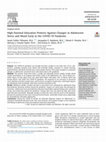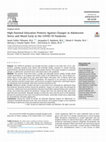Papers by Sarah Collier Villaume
JAMA network open, Nov 29, 2023
Journal of Adolescent Health
Psychoneuroendocrinology, Jul 1, 2023
Psychoneuroendocrinology, Sep 1, 2019
Current Opinion in Psychology

Development and Psychopathology, 2020
We review evidence of racial discrimination as a critical and understudied form of adversity that... more We review evidence of racial discrimination as a critical and understudied form of adversity that has the potential to impact stress biology, particularly hypothalamic–pituitary–adrenal (HPA) axis activity. We highlight ethnic racial identity (ERI) as a positive regulatory influence on HPA axis activity, as indexed by levels of salivary cortisol. In past research by our group, Black individuals with high adolescent discrimination had low adult cortisol levels (hypocortisolism). Here, we present new analyses showing that ERI, measured prospectively from ages 12 through 32 in 112 Black and white individuals, is related to better-regulated cortisol levels in adulthood, particularly for Black participants. We also describe ongoing research that explores whether the promotion of ERI during adolescence can reduce ethnic–racial disparities in stress biology and in emotional health and academic outcomes.
Psychoneuroendocrinology, 2019
Psychoneuroendocrinology, 2019
APA handbook of adolescent and young adult development.

Journal of Adolescent Health, 2021
The COVID-19 pandemic has brought dramatic changes to the daily lives of U.S. adolescents, includ... more The COVID-19 pandemic has brought dramatic changes to the daily lives of U.S. adolescents, including isolation from friends and extended family, transition to remote learning, potential illness and death of loved ones, and economic distress. This study's purpose is to measure changes in adolescents' perceived stress and mood early in the pandemic. Methods: The present study drew from a racially and ethnically diverse sample of high school student participants in an ongoing intervention study in the Midwestern U.S., 128 of whom provided reports of their daily stress and mood both before (December 2017 to March 2020) and during (MarcheJuly 2020) the COVID-19 pandemic. We expected to see increases in perceived stress, declines in positive mood states, and increases in negative mood states, with larger impacts on individuals from households with lower parental education levels. Results: Multilevel models revealed increases in perceived stress primarily for adolescents from low/moderate education families during the pandemic. Impacts on mood states also diverged by education: adolescents from low/moderate education households reported feeling more ashamed, caring, and excited than before the pandemic, changes that were not shared by their peers from high education households. Although changes in mood that arose with the onset of the pandemic became less pronounced over time, increased levels of home-and health-related stress stayed high for low/moderate education adolescents. Conclusions: During the COVID-19 period, we observed disparate impacts on adolescents according to household education level, with more dramatic and negative changes in the emotional well-being of adolescents from low/moderate education households.
R esearch, intervention, and policy focused on identifying solutions for disparities in child hea... more R esearch, intervention, and policy focused on identifying solutions for disparities in child health and developmental outcomes are gaining insight from a new source: the study of stress biology. Recent theoretical models have implicated disparities in stress exposure and the biological consequences of

Journal of Adolescent Health, 2021
The COVID-19 pandemic has brought dramatic changes to the daily lives of U.S. adolescents, includ... more The COVID-19 pandemic has brought dramatic changes to the daily lives of U.S. adolescents, including isolation from friends and extended family, transition to remote learning, potential illness and death of loved ones, and economic distress. This study's purpose is to measure changes in adolescents' perceived stress and mood early in the pandemic. Methods: The present study drew from a racially and ethnically diverse sample of high school student participants in an ongoing intervention study in the Midwestern U.S., 128 of whom provided reports of their daily stress and mood both before (December 2017 to March 2020) and during (MarcheJuly 2020) the COVID-19 pandemic. We expected to see increases in perceived stress, declines in positive mood states, and increases in negative mood states, with larger impacts on individuals from households with lower parental education levels. Results: Multilevel models revealed increases in perceived stress primarily for adolescents from low/moderate education families during the pandemic. Impacts on mood states also diverged by education: adolescents from low/moderate education households reported feeling more ashamed, caring, and excited than before the pandemic, changes that were not shared by their peers from high education households. Although changes in mood that arose with the onset of the pandemic became less pronounced over time, increased levels of home-and health-related stress stayed high for low/moderate education adolescents. Conclusions: During the COVID-19 period, we observed disparate impacts on adolescents according to household education level, with more dramatic and negative changes in the emotional well-being of adolescents from low/moderate education households.











Uploads
Papers by Sarah Collier Villaume